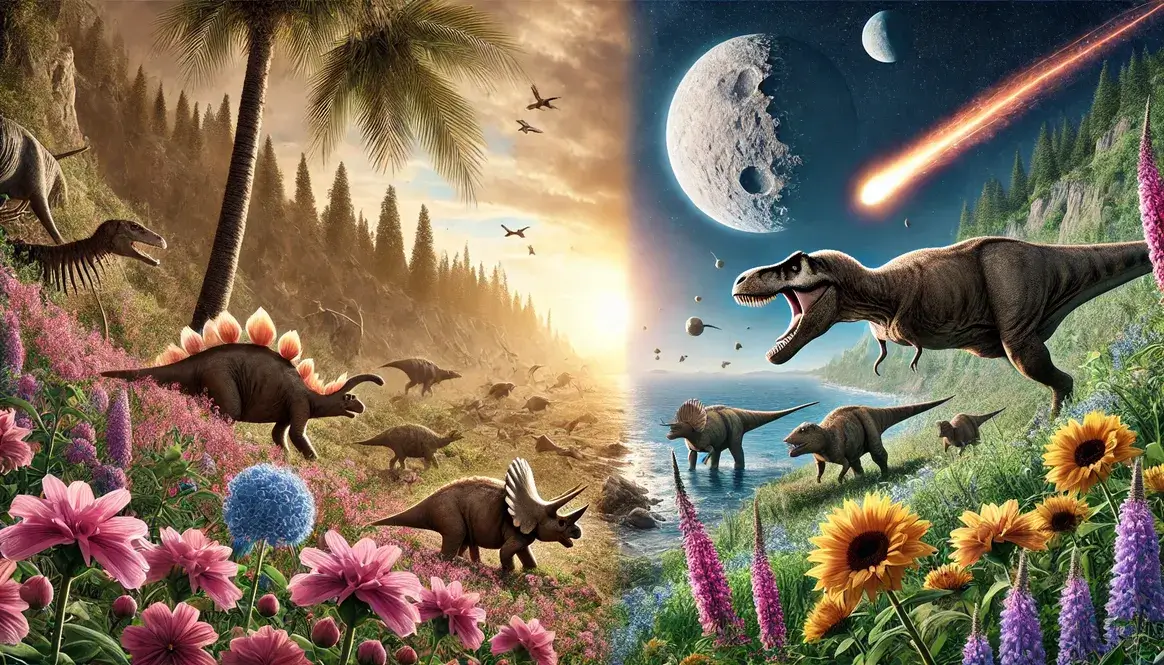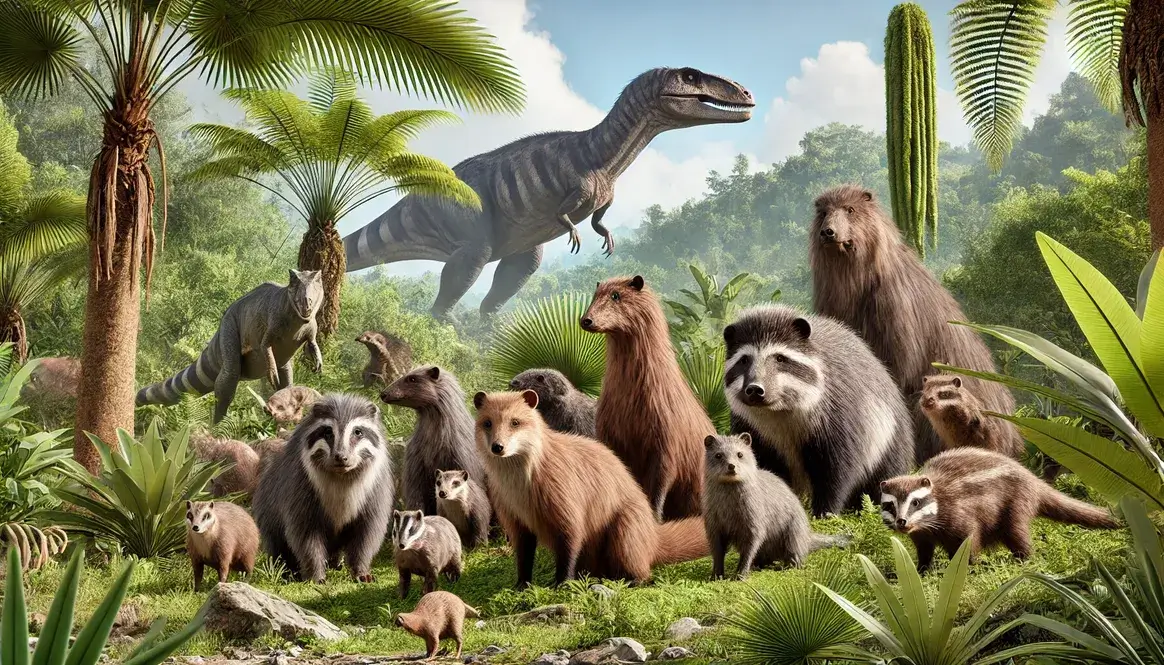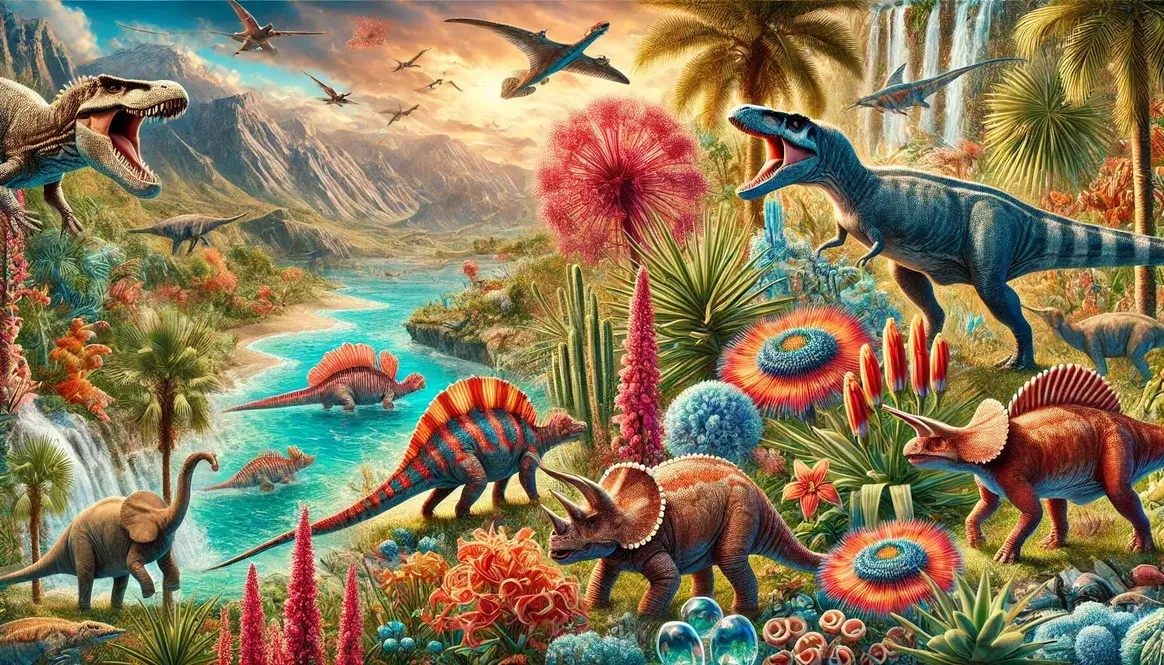The Cretaceous period, spanning from 145 to 66 million years ago, was a time of incredible change on Earth. This era saw the rise and fall of some of the most fascinating creatures to ever roam our planet, along with dramatic shifts in climate, geography, and ecosystems.
Imagine a world where flowering plants were just beginning to bloom, where massive reptiles ruled the skies and seas, and where the continents were slowly drifting into the positions we know today. This was the Cretaceous – a time of innovation and transformation in Earth’s history.
Major changes in Cretaceous: A timeline of transformation
To truly grasp the scope of changes that occurred during the Cretaceous, it’s helpful to look at them in chronological order. This approach allows us to see how each change built upon the last, creating a domino effect of evolution and adaptation.
Understanding these changes is crucial for several reasons:
- Evolutionary insights: The Cretaceous period provides valuable information about how life adapts to changing environments over long periods.
- Climate change lessons: By studying the climate shifts of the Cretaceous, we can better understand current and future climate change.
- Biodiversity appreciation: The explosion of new life forms during this time helps us appreciate the importance of biodiversity.
- Extinction event understanding: The end-Cretaceous mass extinction offers insights into how life recovers from catastrophic events.
Let’s embark on a journey through time, exploring the major changes that shaped the Cretaceous world and set the stage for the modern Earth we know today.
Early Cretaceous: Seeds of change (145-100 million years ago)
The Early Cretaceous was a time of significant transformation, setting the stage for the dramatic changes that would unfold throughout the period. Let’s explore the key developments that occurred during this time.
Breakup of Gondwana
One of the most significant changes during the Early Cretaceous was the ongoing breakup of the supercontinent Gondwana. This massive landmass, which included what would become South America, Africa, Antarctica, Australia, and India, began to fragment, leading to:
- Formation of new coastlines and seas
- Changes in ocean currents and weather patterns
- Creation of isolated ecosystems, promoting unique evolutionary paths
The shifting continental configurations had far-reaching effects on both climate and ecosystems. As landmasses moved, new mountain ranges formed, altering air circulation patterns and creating diverse habitats. These changes set the stage for the evolution of new plant and animal species, contributing to the rich biodiversity of the Cretaceous period.
Rise of angiosperms
Perhaps the most revolutionary change of the Early Cretaceous was the emergence of flowering plants, or angiosperms. This new group of plants would go on to dominate the Earth’s flora, but their beginnings were humble:
| Time (million years ago) | Angiosperm Developments |
|---|---|
| 145-130 | First angiosperm fossils appear |
| 130-120 | Increased diversity in fossil record |
| 120-100 | Rapid spread and diversification |
The rise of flowering plants had profound effects on terrestrial ecosystems. These plants formed new relationships with insects, leading to co-evolution of many species. The rapid spread of angiosperms also provided new food sources for herbivorous dinosaurs, influencing their evolution.
Diversification of dinosaurs
The Early Cretaceous saw significant changes in dinosaur populations. New herbivorous groups emerged, adapting to the changing plant life. Among these were:
- Early hadrosaurs, or duck-billed dinosaurs
- Primitive ceratopsians, ancestors of horned dinosaurs
- Early ankylosaurs, the armored dinosaurs
Meanwhile, the carnivorous dinosaurs were also evolving. The early tyrannosaurs, though not yet the giants they would become, were developing the features that would make them formidable predators. These early tyrannosaurs were generally smaller and more agile than their later descendants, but they were already showing signs of the powerful jaws and keen senses that would characterize the group.
The diversification of dinosaurs during this time laid the groundwork for the incredible variety of Cretaceous predators and plant-eating dinosaurs that would dominate the later Cretaceous landscape.
Mid-Cretaceous revolution (100-80 million years ago)
The Mid-Cretaceous period marked a time of rapid change and innovation across various ecosystems. This era saw significant developments in plant life, marine environments, and dinosaur populations, setting the stage for the iconic Late Cretaceous world.
Flowering plant explosion
The Mid-Cretaceous witnessed an unprecedented boom in angiosperm diversity and distribution. This flowering plant explosion transformed landscapes across the globe:
- Rapid diversification: Angiosperms evolved into numerous new forms, adapting to various environments.
- Increased dominance: Flowering plants began to outcompete other plant groups in many ecosystems.
- Novel structures: New flower types and fruit-bearing plants emerged, offering new food sources.
This botanical revolution didn’t occur in isolation. The diversification of flowering plants was closely tied to the evolution of insects. As plants developed new floral structures, insects evolved specialized feeding and pollination mechanisms. This co-evolution led to intricate relationships between plants and insects, many of which persist to this day.
Marine reptile innovations
While changes were happening on land, the Cretaceous seas were experiencing their own revolution. The Mid-Cretaceous saw significant innovations among marine reptiles, particularly in two key groups:
- Mosasaur radiation: These marine lizards underwent rapid diversification during this time. From relatively modest beginnings, mosasaurs evolved into a wide array of species, ranging from small coastal predators to enormous open-ocean hunters. Their success was partly due to their unique adaptations, including paddle-like limbs and a shark-like tail fin for efficient swimming.
- Plesiosaur changes: The long-necked plesiosaurs, which had been around since the Triassic, saw interesting population changes. Some groups declined, while others, like the short-necked, large-headed pliosaurs, continued to thrive as apex predators.
These shifts in marine reptile populations had significant impacts on Cretaceous ocean ecosystems, influencing everything from prey species to smaller predators.
Dinosaur fauna turnover
The Mid-Cretaceous also marked a period of significant change for dinosaur populations. This era saw the decline of some well-established groups and the rise of others that would come to define the Late Cretaceous.
Declining groups:
- Stegosaurs: These plate-backed herbivores, which had been successful since the Jurassic, began to fade from the fossil record.
- Allosaurs: Once apex predators, these large theropods were gradually replaced by other carnivorous dinosaurs.
Rising stars:
As older groups declined, new herbivore groups began to flourish. The Mid-Cretaceous saw the rise of:
| Herbivore Group | Key Features | Ecological Role |
|---|---|---|
| Hadrosaurs | Duck-like bills, complex teeth | Efficient grazers |
| Ceratopsians | Frilled heads, horned faces | Tough plant eaters |
| Ankylosaurs | Heavily armored bodies | Low-browsing herbivores |
These new herbivore groups were better adapted to process the tough, fibrous plants that were becoming increasingly common as angiosperms spread. Their success, in turn, influenced the evolution of Cretaceous predators, setting the stage for the iconic dinosaur ecosystems of the Late Cretaceous.
The Mid-Cretaceous revolution reshaped life on Earth, from the smallest flowering plants to the largest marine predators. These changes would continue to unfold, leading to the diverse and fascinating world of the Late Cretaceous.
Late Cretaceous: Age of giants and specialists (80-66 million years ago)
The Late Cretaceous marked the pinnacle of many evolutionary trends that had been developing throughout the period. This era saw the emergence of some of the most iconic prehistoric creatures, as well as surprising developments in less celebrated groups.
Peak of dinosaur diversity
The Late Cretaceous witnessed an explosion of dinosaur diversity, with many groups reaching their evolutionary zenith. This period saw the emergence of some of the most famous dinosaurs in popular culture, including the mighty Tyrannosaurus rex.
T. rex, with its massive skull and powerful bite force, represents the apex of theropod evolution. But it wasn’t alone in its dominance. Other formidable Cretaceous predators like Spinosaurus and Giganotosaurus also roamed during this time, each adapted to different hunting strategies and environments.
Among herbivorous dinosaurs, specialization reached new heights:
- Hadrosaurs: These “duck-billed” dinosaurs developed complex dental batteries for efficient plant processing.
- Ceratopsians: Horned dinosaurs like Triceratops evolved elaborate frills and horns, likely for display and defense.
- Sauropods: While less diverse than in earlier times, titanosaurs became the dominant long-necked herbivores in many ecosystems.
This specialization allowed different herbivore groups to coexist by exploiting different plant resources, contributing to the overall diversity of Late Cretaceous ecosystems.
Extreme pterosaur sizes
The Late Cretaceous saw pterosaurs push the boundaries of vertebrate flight. Some species evolved to enormous sizes, with wingspans reaching up to 10-11 meters. The largest known pterosaur, Quetzalcoatlus, was as tall as a giraffe when standing on the ground!
These giant pterosaurs represent an interesting evolutionary experiment:
| Adaptation | Function | Ecological Implication |
|---|---|---|
| Hollow bones | Weight reduction | Enabled larger size while maintaining flight capability |
| Elongated necks | Increased reach | Allowed for diverse feeding strategies |
| Reduced teeth or toothlessness | Weight reduction | Shifted diet towards softer prey or filter feeding |
The evolution of these aerial giants had significant ecological implications. They likely filled niches similar to modern large birds, potentially acting as apex predators in some environments and competing with dinosaurs for certain resources. However, their extreme size may have also made them vulnerable to extinction when environmental conditions changed.
Mammal diversification
While dinosaurs often steal the spotlight, the Late Cretaceous also saw significant developments in mammal evolution. Despite living in a world dominated by reptiles, mammals were quietly diversifying and exploring new ecological niches.
The increase in mammal species diversity during this time was remarkable. New groups emerged, including:
- Early primates
- Primitive rodent-like mammals
- Ancestors of modern marsupials and placentals
These mammals were finding success in a variety of ecological niches:
- Arboreal habitats: Some mammals adapted to life in the trees, taking advantage of the complex forest environments created by flowering plants.
- Burrowing lifestyles: Other mammals evolved to live underground, escaping predation and exploiting new food sources.
- Nocturnal activities: Many Cretaceous mammals were likely nocturnal, avoiding competition with diurnal dinosaurs.
This diversification laid the groundwork for the mammalian radiation that would occur after the end-Cretaceous extinction event. The Cretaceous mammals, though small and often overlooked, were setting the stage for their future dominance.
The Late Cretaceous truly was an age of evolutionary marvels, from gigantic predatory dinosaurs to soaring pterosaurs and the humble but diverse mammals. Each group was pushing the boundaries of adaptation, creating a world of remarkable biodiversity on the eve of a great change.
Global climate shifts throughout the Cretaceous
The Cretaceous period was characterized by significant climate changes that had far-reaching effects on both terrestrial and marine ecosystems. These shifts played a crucial role in shaping the evolution and distribution of life forms during this time.
Warming trends
The Cretaceous was markedly warmer than our current climate, with global average temperatures estimated to be 3-4°C higher than today. This warming trend was not uniform throughout the period but intensified over time, reaching its peak in the Late Cretaceous.
Several factors contributed to this warmer climate:
- Elevated CO2 levels: Atmospheric carbon dioxide concentrations were significantly higher than present-day levels.
- Increased volcanic activity: Extensive volcanism released greenhouse gases into the atmosphere.
- Continental configuration: The breakup of Pangaea altered ocean currents and atmospheric circulation patterns.
The impact of this warmer climate on Cretaceous flora and fauna was profound:
- Expanded habitable zones: Warmer temperatures allowed plants and animals to thrive in higher latitudes.
- Absence of polar ice caps: The poles were free of permanent ice, supporting unique polar ecosystems.
- Increased biodiversity: Warmer, more stable climates fostered greater species diversity in many regions.
These warming trends influenced the evolution of various groups. For instance, the Cretaceous climate likely played a role in the diversification of flowering plants, providing favorable conditions for their spread and adaptation.
Sea level fluctuations
Another key aspect of Cretaceous climate change was significant fluctuations in sea levels. Overall, sea levels during the Cretaceous were much higher than today, but they weren’t static throughout the period.
| Time | Sea Level Relative to Present |
|---|---|
| Early Cretaceous | ~100 meters higher |
| Mid-Cretaceous | ~200 meters higher |
| Late Cretaceous | ~150 meters higher |
These high sea levels led to the creation of extensive shallow seas, dramatically altering the Earth’s geography. One of the most significant results was the formation of large inland seas, such as the Western Interior Seaway that split North America into two landmasses.
The effects of these sea level changes on life were substantial:
Terrestrial impacts:
- Reduced land area, leading to increased competition for resources
- Creation of isolated “island” habitats, promoting speciation
- Changes in migration routes for land animals
Marine impacts:
- Expansion of shallow marine environments
- Increased habitat for reef-building organisms
- New opportunities for marine reptiles and fish species
The fluctuating sea levels of the Cretaceous had a particularly strong influence on Cretaceous ocean life. The vast shallow seas provided ideal conditions for the diversification of marine reptiles like mosasaurs and plesiosaurs, as well as for the evolution of new fish species.
These global climate shifts throughout the Cretaceous period set the stage for the incredible biodiversity that characterized this era. From the lush polar forests to the teeming inland seas, the Cretaceous world was one of constant change and adaptation, shaping the course of evolution for millions of years to come.
Cretaceous mass extinction: The final act
The Cretaceous period came to a dramatic close with one of the most significant mass extinction events in Earth’s history. This event, known as the Cretaceous-Paleogene (K-Pg) extinction, marked the end of the Age of Dinosaurs and set the stage for the rise of mammals.
Signs of impending change
In the lead-up to the mass extinction, several environmental stressors were already at play, hinting at the upheaval to come.
Deccan Traps volcanism
One of the most significant factors was the intense volcanic activity in what is now India, known as the Deccan Traps. This massive outpouring of lava had far-reaching consequences:
- Release of enormous quantities of greenhouse gases
- Injection of sulfur aerosols into the atmosphere
- Potential toxic metal contamination of ecosystems
The Deccan Traps eruptions likely contributed to gradual climate shifts and environmental stress in the late Cretaceous. Some scientists argue that this volcanism played a significant role in the mass extinction, either independently or in conjunction with the asteroid impact.
Gradual climate shifts
Alongside the volcanic activity, the late Cretaceous saw ongoing climate changes:
- Cooling trends in some regions
- Sea level fluctuations
- Changes in ocean circulation patterns
These shifts put pressure on many species, potentially making them more vulnerable to rapid environmental change. The Cretaceous climate was already in flux, setting the stage for the catastrophic events to come.
The asteroid impact
While environmental stressors were building, the coup de grâce came in the form of a massive asteroid impact. This cosmic collision, which occurred near present-day Chicxulub, Mexico, had devastating immediate and long-term effects.
Immediate effects:
| Effect | Description |
|---|---|
| Global wildfires | Ignited by the impact’s heat pulse |
| Mega-tsunamis | Devastated coastal regions worldwide |
| Earthquake activity | Triggered by the impact’s shock waves |
| Acid rain | Caused by vaporized rock and seawater |
Long-term effects:
The most significant long-term effect was the infamous “impact winter.” Dust and aerosols thrown into the atmosphere blocked sunlight for months or years, leading to:
- Collapse of photosynthesis-based food chains
- Rapid global cooling
- Widespread ecosystem collapse
This combination of effects led to the extinction of approximately 75% of plant and animal species on Earth, including all non-avian dinosaurs.
The aftermath of the K-Pg extinction event set the stage for the Age of Mammals. With the large dinosaurs gone, surviving mammals found new opportunities to diversify and occupy vacant ecological niches. This paved the way for the evolution of the diverse mammalian fauna we see today, including our own species.
The Cretaceous fossil discoveries from this time provide crucial evidence for understanding this pivotal moment in Earth’s history. They offer a window into the world before and after the extinction, helping scientists piece together the story of life’s resilience and adaptability in the face of catastrophic change.
The Cretaceous mass extinction serves as a stark reminder of the fragility of life and the profound impact that global catastrophes can have on Earth’s ecosystems. It marked the end of one era and the beginning of another, fundamentally reshaping the course of evolution on our planet.









